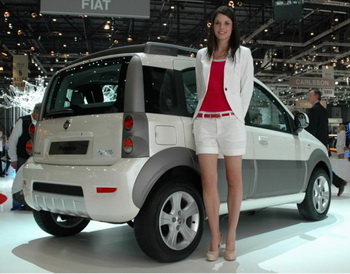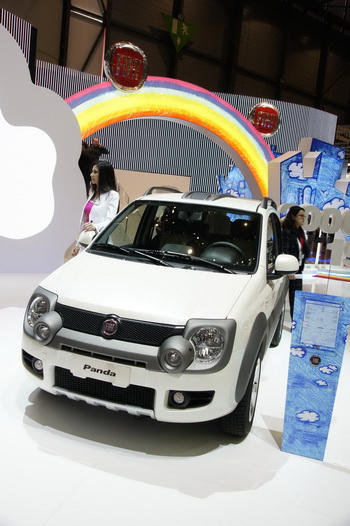

 |
|
With a cake and candles the tiny Fiat Panda
has celebrated its 30th birthday in Geneva
(above) as exactly 30 years ago at the same
Swiss motor show the first-generation model
was launched before going on to be a true
global automotive hit. |
|
|
|
|
With a cake
and candles the Fiat Panda has celebrated its 30th
birthday in Geneva as exactly 30 years ago at the Swiss
motor show, at the 1980 edition, the first-generation
model was launched before going on to be a true global
hit - and, with 6 million units registered, is
established as by far the most widely sold city-car. In
Geneva the range is represented by the Panda Cross
version, a chunky, off-road capable "mini SUV".
The "Panda"
model is part of Fiat's heritage, which represented a new
and unmistakable way of seeing the everyday relationship
with the car in automotive history and Italian society: more
immediate, more natural, easier. That's why, over time, the
Panda has become almost a brand, with strong emotional
value, to which Italian and European drivers have always
been profoundly attached.
Following in the
footsteps of an established best-seller, the new Panda
debuted in September 2003, bearing not only the name but
also the spirit of the model, translating the product values
and personality that made it a genuine icon in the
collective imagination into today's language. However while
the reuse of the Panda name has proved to be a huge success
it only came about by accident after Fiat was forced into a
last minute name change. The rather anonymous name "Gingo"
had in fact been pencilled in for the new model, but a
threat of legal action from Renault, which felt this was too
close to the name of its own "Twingo" city car, saw Fiat
hastily revive the Panda tag. The new Panda has established
itself as A-segment's undisputed leader within its 6 years
of production and suffice it to say that from its launch to
the present day 1.5 million units have been produced and it
closed 2009 with a record 300,000 cars sold.
The commercial
success of the new Fiat Panda is also accompanied by the
bestowal of many international awards, among which the
prestigious Car of The Year 2004 which, for the first
time, was given to a car in this segment. In addition, the
car's position in the segment is established by certain
records: for example, it was the first spacious compact
(less than 4 metres in length) to feature a diesel engine
(1986) and, again in this category, it was the first to
offer both four-wheel drive (1983) and a range of
eco-friendly engines designed to limit fuel consumption (the
Panda Elettra was introduced in 1990, one of the first
electric cars). Also, in 2004, 2 Panda 4x4s took part in an
audacious test drive which began in Kathmandu (Nepal) and
ended at Everest's high-tech base camp: it was the first
time that a little off-road vehicle reached this base at an
altitude of 5,200 metres. An even more extraordinary feat if
you bear in mind that the two cars were prepared only by
making some modifications to the calibration of the engine
management control unit to adapt them to the local petrol.
A curious fact:
while, 30 years ago, an average employee would have had to
spend 9 months' salary to buy a Panda (3,700,000 Italian
liras), today, 6 months' worth are enough to buy the same
car. The Panda has been able to stay in step with the times
both in terms of functionality and quality/price ratio.
However, the Panda is more than a city-car. It is a genuine
"platform" on which Fiat has created an entire family of
cars with the technology and attention to detail of a higher
segment.
Finally, the
Fiat Panda has recently undergone a light but expert
makeover, without giving up the winning characteristics of
Fiat's super-compact: innovative design, advanced technology
made accessible to all and smart solutions to simplify and
improve on-board comfort. Today, the new range includes
engines both traditional (petrol and diesel, from 54 to 100
HP) and alternative engines (methane and LPG), combined with
manual or robotised, sequential gearboxes (Dualogic), as
well as versions with front-wheel or four-wheel drive, the
latter enhanced by an Electronic Locking Differential in
combination with the ESP (Electronic Stability Program).
That's without mentioning the Special Series, created using
the new vehicle as their model: from the Panda Monster, the
4x4 jointly-created by Fiat and Ducati (2006), to the
Pandakars which braved the well-known rally in 2007; from
the Panda Capri, which offered an exclusive courtesy service
on the famous island, to the Panda Mamy, dedicated to
mothers, with a wealth of standard equipment for safely
transporting the smallest passengers (2008); from the Panda
Alessi, a true design object, to the latest two versions,
4x4 Glam and Adventure (2009).
|